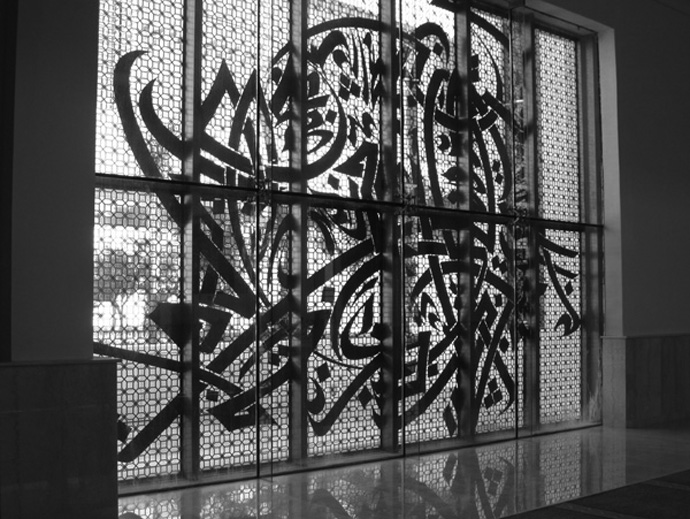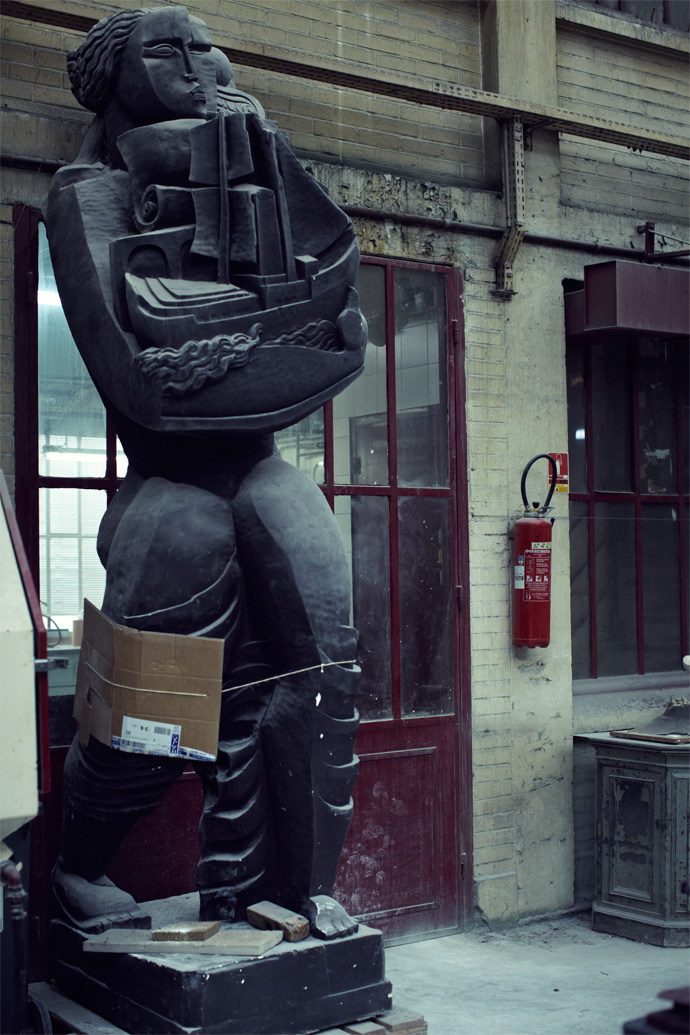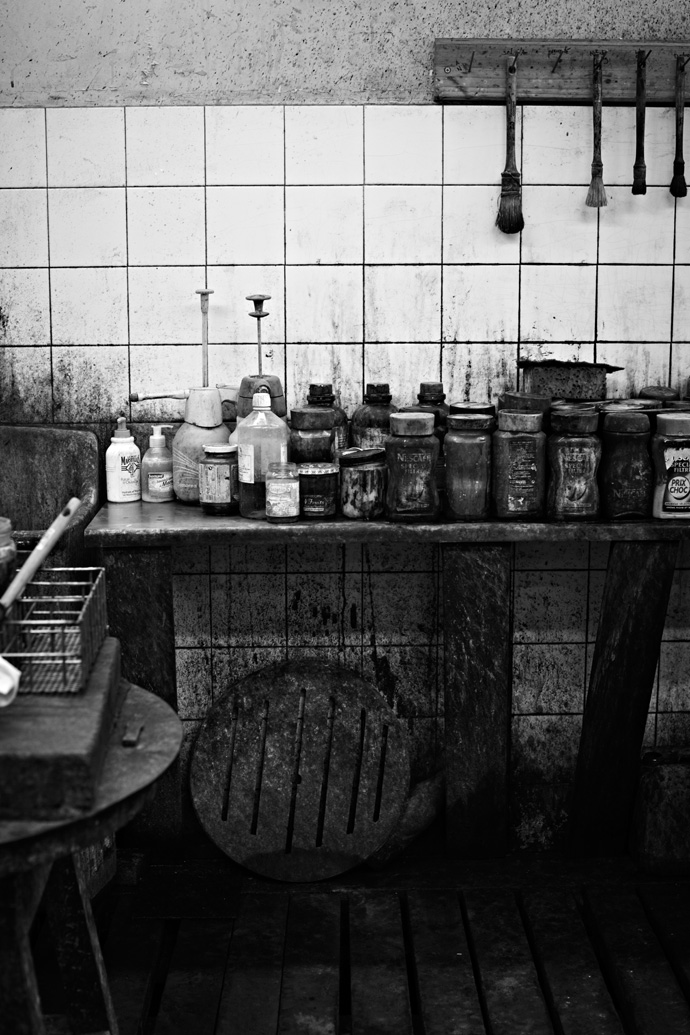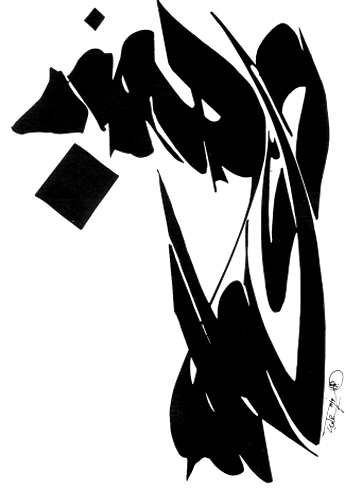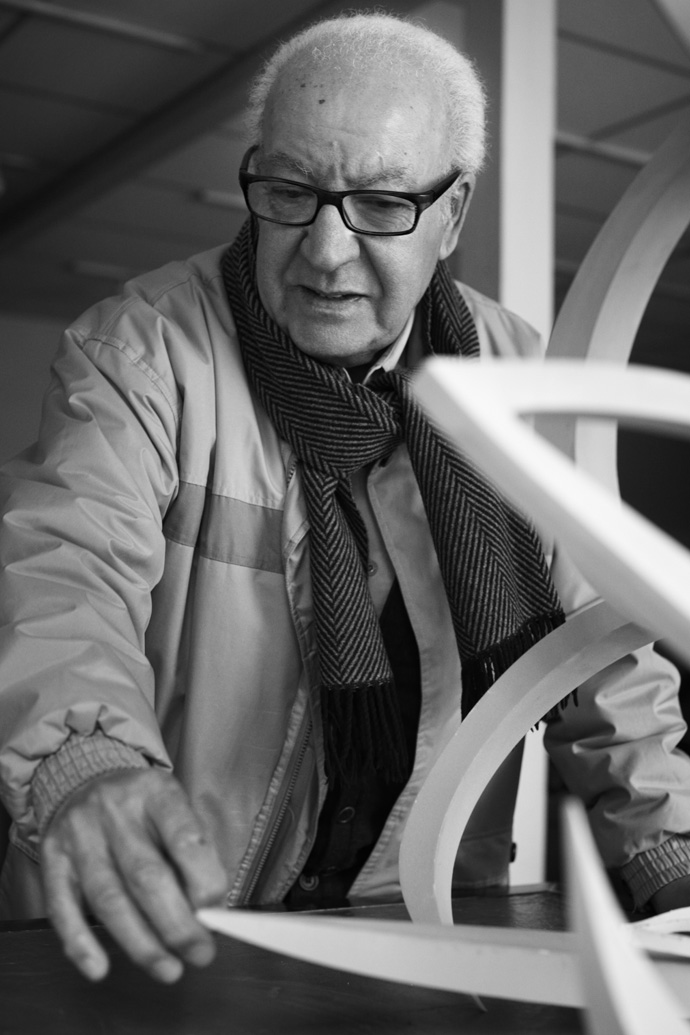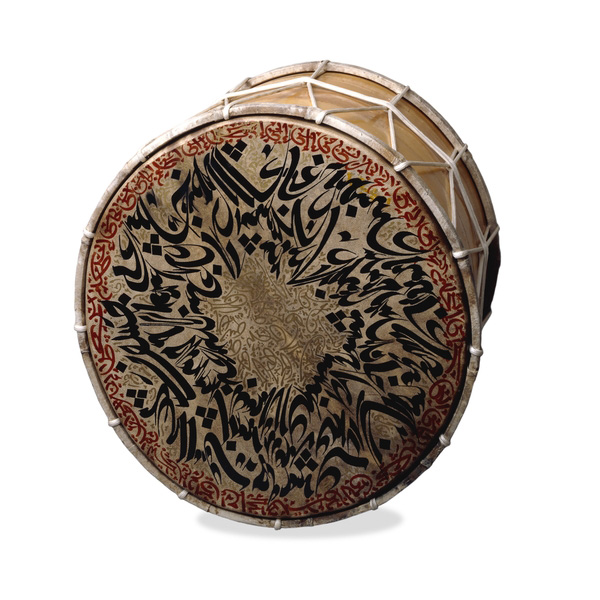NJA MAHDAOUI: strokes of liberation
Nja Mahdaoui is one of the most celebrated living contemporary artists in the arab world. His bold and highly rhythmic work, derived from the arabic letter, is internationally renowned and can be found in ther permanent collections of the Institut du Monde Arabe, The British Museum and The Smithsonian Institution just to name a few.
It’s an exuberance of arabesque forms, a visual melody played out of his hand, that remind us of the great gestural and physical richness of action painting. Famous for his meticulous inks on parchment, this “liberated calligraphy” is worked across a variety of extremely different surfaces — from canvas, brass, wood, melamine and papyrus to skin. Though It seems like writing, it is not. It is rather an interlacing of a dialectic relationship, also found within Western abstraction.
Naomi Campbell in Azzedine Alaïa for Numéro Magazine. A collaboration between Nja Mahdaoui and René Habermacher
I came across the work of Nja Mahdaoui the first time, while researching calligraphic styles on a project for the French magazine Numéro on a piece about Azzedine Alaïa to which Babeth Djian incited me. The visual impact of Nja’s work struck me at first sight.
Slightly intimidated by the references of the rich body of his work, I first hesitated but then thought to give it a shot, and contacted him. To my surprise he answered me instantly by email, and called me shortly after. Our collaboration was set — and we created a story of imaginary movements around Naomi Campbell as a dark gazelle, in sheer and revealing Alaïa.
But I only met Nja Mahdaoui in person two summers ago in Tunis. It was an all-embracing, hot and sultry August day that lay heavy on the city, matching the emotional state of its people.
Nja Mahdaoui wit the first prototype of his most recent sculpture. Photography by René Habermacher
A couple of months after the “Jasmine revolution” took place, Nja arrives in full swing to our meeting at a café in sunny, springtime Paris.
He’d come with his daughter Molka Mahdaoui to work on another of his new projects, yet is consumed with excitement by the events. He reacts immediately and impulsively to the question I usually ask last on conversations for The Stimuleye: What is the last thing that stimulated you?
“Stimulated? You’re asking a Tunisian? (laughs). I don’t know if ‘stimulated’ is the word, but it’s the explosion of a generation, I’m completely into it — for us it’s the event of the century!”
Nja Mahdaoui: "Graphemes on Arches 2", 2009, Ink on arches paper; 135cm x 135cm.
With us at the table are the collaborators involved in the process of making his latest project, a sculpture, the main reason for his trip north. Nja loves collaborations – his eyes glow while he talks energetically about upcoming projects. An energy I felt the first time I saw his bold and highly rhythmic work: “a dance of calligraphy”, with Nja as the choreographer of imaginary letters, to which he refers as ‘graphemes’, devoid of actual textual meaning:
“To a non-Arabic speaker it appears as coherent text. In fact even Arabic speakers assume at first that it’s a text with meaning. But when they start reading it they realise it is not an actual word.” he says and recalls an experience:
“It is not easy to write letters in a disjointed way — that is disjointed to not mean anything — and focus only on the aesthetic. There was a study at the California Institute of Technology in Pasadena. They connected me to a machine in order to test the levels of stress my body was under when I was writing proper words and when I was writing words without meaning. The study showed that my body was 2.5 times more stressed when I was working on words without meaning. So it is a very conscious attempt to create art. I tell people I’m not a calligrapher, but an artist.”
To me his body of work is so vibrant and remarkably innovative that I first had assumed Nja to be in his early 30’s the most, yet he was born in La Marsa, Tunisia, in 1937. As Molka, a filmmaker herself, puts it during our conversation: “sometimes i have to remind myself: Molka, you are thinking older than your own father!”.
Nja Mahdaoui: Design for Gulf Air 50th Anniversary. Image Courtesy of Nja Mahdaoui
Indeed his energy is striking, he takes part vividly in public life in constant dialogue and is virtually hooked to Facebook, like a teenager:
“Blogs are not simple, it’s in between the magazine you buy, the TV news, and the private lives of people. To balance it out you need to create a dialog, create communication in a domain. Who’s the most motivated? Communication is very important. In Tunisia, a great part of the revolt was started by bloggers: The main one was jailed, he’s a good friend of mine, his wife is a filmmaker […] He was a hacker, a net-pirate, and today he is the Secretary for Youth. Seems like a joke!
On the eve of the revolt in Cairo, young Tunisians were able to get around Egypt’s net blockade, and pass information along to people. Internet has developed a lot in Tunisia, we’ve had cheap access for everyone for years, so everyone is connected.”
And Nja stays very connected- to these very times on which he checks repeatedly with his iPhone during our conversation- the recent uprising in Lybia for example: “I love the Libyan people, but there’s very little connection with Tunisia.”
Ferid, a friend of mine that had met with us at our first meeting in Tunis in 2009 was astonished by the freedom of speech Nja took for himself and the cause of others, even under the regime of president Ben Ali: “He can say things that no one would dare, even on TV!”
Nja Mahdaoui: Window screen for the Kaust Mosque in Thuwal, Mecca. Image Courtesy of Nja Mahdaoui
“Tunisia is a country where, out of 10 million inhabitants, over half are young, and where since independence, education has been a priority. We’re in a country which has invested in culture and knowledge, and has many unemployed graduates with diplomas. Our problem is to have thousands and tens of thousands of graduates for which we need to find positions. Especially since we don’t have any oil!!! I think it’s a good thing not to have oil, it seems like a poisoned gift… Anyway nature has decided for us. But there is the black gold of intelligence, knowledge and communication!”
“Our network is amazing. The new boss of the Central Tunisian Bank was until recently an economics professor in the USA. One of the first things to do is to have an assessment. He determined in a report that 23 kilos of gold had been used for medals. Some of these medals are given by the Ministry of Culture – I’ve received some myself.
[After the revolution] I immediately made an article, “The Medals of Shame”: we thought these medals were a distinction, but if we learn that they were made with gold stolen from the people’s money, I propose that we give these medals back to the Central Bank and have them melted to create some funds for those in need. Some artists wrote back to me “these medals are our diplomas”! Que Dio! Aren’t they ashamed of themselves!”
The Susse Foundry in Paris and Nja Mahdaoui at work. Photography by René Habermacher
Time has come to move, and we leave the sunshine of the cafe’s terrasse to the Susse Foundry that was created in 1758, where the draft of Nja’s sculpture is awaiting us. Nja going ahead: “The Susse Foundry is the most ancient in France. In the world of art, it’s a reference. They make objects as if it was 1901, so they’re a bit shaken up by what is going on today — it’s the first work they make with a technical team from the future.”
Susse’s workshops are in an undistinguished building. Only a bronze shingle identifies the door next to a partly frosted glass window through which one can glimpse a plaster angel negligently hung upside down. Some of the finest sculptors of the 20th century have produced here: Jean Arp, Henry Moore, Germaine Richier, Picasso, Giacometti, Braque, Dali and Chagall.
Manuel Delétré is a meticulous craftsman and joins us at the door with Hubert Lacroix. The foundry’s halls are softly lit through ceiling windows — stacks of molds, sculptures and work-tools fade into gloomy shadows towards the dark embracing walls.
Nja Mahdaoui: Ink on Paper for Cahier Horizons Maghrébins.
The techniques employed at Susse are ancient: ‘lost wax’, the method of classical and renaissance sculptors and ‘sand casting’ for which Susse uses a sand found only in the Seine basin.
And here is Nja, breaking into this world of great heritage with fresh vision and the help of modern inventions:
“In my path I’ve tried sculpture, but not in a classic sense with clay. I’m not a sculptor, but I am for contemporary creation. I go full steam ahead, without hesitation, when it comes to technical challenges. We started with a 2D graphic, but spun it around constantly to get a 3D volume. I’m so happy to say ‘don’t be afraid ! it’s the future !’ If there’s a way, if it exists, then to turn your back and close your eyes is idiotic. It captivates me!”
He shows us the first model of his work, in one of the back rooms where the blue prints to many great works are stored.
Nja is captivated- following the lines of the sculptures with his hands- as caressing it and finishing off the strokes of his calligraphy drawing in the air: “The total piece consists of 22 separate elements that are arranged around the axis” he explains. “The sculpture is meant for… the love of creation”. The final cast will be moulded in June, followed by the process of applying the patina, for which Susse is famous – applying secret acids in order to produce mordant greens, equatorial blues and a glossy black.
In 3 months from now, another circle will becoming full: “We had been looking for years for a graphic designer with the knowledge to go from 2D to 3D, until then all we had been able to do was to give depth, to make an extrusion. It’s the quest of innovation, the challenge of going further.” He has found the process liberating, being free from the confines of two-dimensional space. This is reflected in the energy and dynamism of the new piece.
Nja Mahdaoui: "The sculpture is meant for… the love of creation" Photography by René Habermacher
Over lunch Nja introduces me to another project he is working on, a collaboration with with the Tunisian gallery ‘El Marsa Gallery‘ and the American gallery ‘New Sahara Gallery‘ and CSUN (California State University Northridge):
“For CSU Northridge, I’m putting together the idea of the Behaviour of the Other, the Look of the Other, using all means of communication. So in this installation I’m installing a giant drum, like the one in the British Museum. I’ll bring with me Tunisian sand from the Sahara, a handful to put into a pile of American sand and I mean to have 6 dancers, to whom I am not giving any further instructions. The dancers will listen to these sounds [of the drumsspun], and we’ll try to film the behaviour of the dancers, sitting in front of this drum, and see how long they can resist the urge to dance. Some of these rhythms will get them in the gut. I want to see their automatisms!
From this demand, I await for them to interpret and make their own decisions, decisions of a cultural and political nature. I’m curious to know if [UCSU Northridge] chooses 3 women and 3 men, African-Americans because I’m Tunisian and for them Tunisia = Africa. I’m curious if it’s going to be as mixed as LA is…”
Nja Mahdaoui: Double membrane drum. Collection of The British Museum. Images Courtesy of the British Museum
As knowing Nja I am quite certain he’d prefer this last scenario. Multi-facetted as he is, merging the most diverse inspirations and cultural influences into his work. Collaborating interdisciplinary he recalls an experience at the University of Tokyo in which he and three others from China, India and the West spent hours talking to each other about calligraphy, lettering, styles, forms and mediums — without having a common language.
We ended the day in a pizzeria of the 3rd arrondisement- a loud and hectic place that accomodated our conversation till late at night. Molka joined us again, so did other friends- and among the last guests leaving, Antoine and I accompanied Nja on his stroll home. He insisted to part at Républic: “Paris, this is my City. I know it by heart”
Nja’s exhibiting ‘AZIMUT’ in Los Angeles will run from April through May 2011 at the New Sahara Gallery.
In addition to the exhibit there will be 3 events:
2 events at CSU Northridge University:
– “AZIMUT“ performance at the CSU Northridge University theatre, Tuesday April 12
– a lecture at CSU Northridge University, Thursday April 14,
– a talk at UCLA
1 Comment
-
GREAT GUY ,Great job guys,i loved having pizzawith him and talking ,love his work
